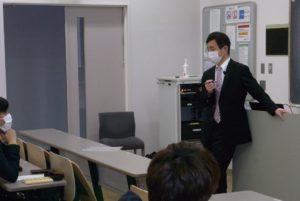理工学部、建築・環境学部教養学会ミニ講演会
第55回理科系学生のための英語講演会
Capillary Pumped Loop: Expertise for Heat Transfer
『キャピラリーポンプループ』
講師: 理工学部理工学科、先進機械コース
辻森 淳
On May 29, 2023, the 55th session of the English Lecture Meeting for Science Major Students was held under the sponsorship of the Academic Society of Faculty of Liberal Arts, inviting Doctor Atsushi Tsujimori of the College of Science and Technology to give a lecture with the above title, which was the 7th lecture for this event given by the lecturer.
Dr. Tsujimori started this lecture with the following words and emphasized the importance of learning English for science major students: “Speaking of science and technology, most of the papers and journals are written in English. You not only have to read English articles but also write your papers in English to notify your own research accomplishment to the world. Therefore, you prospective engineers should try to communicate in English with non-native speaker as well as native speakers of English.”
Professor Tsujimori is a researcher in the field of engineering known as Thermal Engineering「熱工学」; especially, he has been engaged in the research on Heat-Driven Thermal Cycle「熱駆動冷熱サイクル」and High Reliability Cooling Apparatus for Electronic Devices「電子機器の高信頼性冷却」.
As we all know, every mechanical equipment gives off heat as a result of its operation. In this respect, even the most advanced precision instruments mounted on satellites are no exceptions; that is, the heat they produce needs to be removed in some way or another. Otherwise, those instruments would eventually break down, causing mechanical troubles that could disturb regular operations of the satellite. Suppose that technical troubles should take place with equipment on a satellite in space. This problem is quite serious simply because it is almost impossible, or unrealistic, costwise as well as technologywise to repair those broken instruments or replace them with new ones by dispatching a relief team to the satellite.
Dr. Tsujimori showed in this lecture how this great dilemma can be solved by having recourse to a special heat treatment device called capillary pumped loop, of which he is one of the developers. The lecturer showed the audience how this state-of-the-art thermal control device works in space to circulate a working fluid and offers highly effective thermal conductivity, with special emphasis on the fact that the device is designed to operate on one of the fundamental principles of physics, capillary action「毛管作用」, which, as a principle of physics, never fails to take effect in the natural environment, especially in space, thereby contributing to its reliability.
The following are some of the questions and answers exchanged after the main session:
Q. I have learned from class materials and websites that heat pipes can be used in bent conditions. My question is, if they are used in such conditions, does the heat transfer capacity change, as compared with the cases where they are used in the normal straight shape.
私は授業資料とウェブサイトでヒートパイプが曲げる事が可能だと習いました。私の質問はもしヒートパイプを曲げて使用する場合、普通の形状と比較して熱輸送量は変化するかということです。
A. Heat pipes can operate in the top-heat and bottom-heat modes, as well as in a normal horizontal position. The higher the inclination angle from the horizontal axis, the lower the heat transport rate. As the driving force for circulation of a refrigerant in the heat pipe system is capillary pumping force, circulation limit is determined by dropping in frictional pressure of flow, on the one hand and lifting of the liquid head of a refrigerant against gravity force, on the other. In sum, in the top-heat or the bent-up condition, more capillary force is needed than in the normal horizontal condition, resulting in decrease in the heat transport rate.
Q. What is the reason why capillary action was chosen particularly as a way of cooling electronic devices on satellites? In other words, are there any other natural phenomena that could possibly be utilized for heat transfer especially in space? If the answer is positive, what are the advantages that capillary action has as a medium for heat transfer over possible alternatives?
なぜ他の自然現象ではなく毛管現象を冷却に使おうと考えたのか。他の現象で冷却のために利用可能な現象は存在するのか。他の現象に比べて毛管現象が優れているのはどのような点か?
A. First of all, the mechanical pump is obviously the most efficient cooling device, though its lifespan will be at most about 5 years in space. Another possible choice as a method of heat transfer is “thermosyphon,” which is also a mode of passive heat transfer based on convection. When a liquid is converted into a gas, its density will be decreased so that it tends to move upward. While thermosyphon does indeed work as a natural principle for heat transfer, its effect is much smaller than that of capillarity at present: the distance a liquid can be moved is at most a few meters; and the amount of heat that can be transferred is also very small compared with the amount transferrable with capillarity.
2023年5月29日(月)開催


